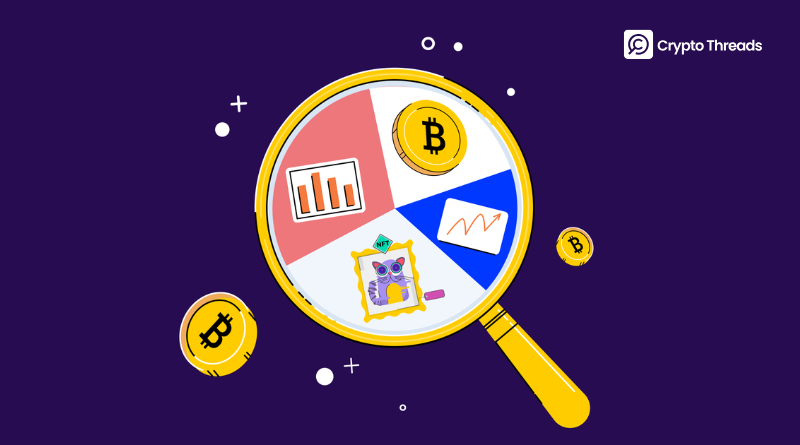Crypto Project Research: DYOR Guide for Smart Investors
Why DYOR Matters More Than Ever
Research on crypto projects has never been more important. In this market, prices, narratives, and hype can shift overnight, and what looks promising today may unravel tomorrow. Even now, with institutional capital entering and regulations improving, risks remain. Projects may appear polished, with strong branding and bold roadmaps, but surface impressions can be deceiving. That’s why DYOR—Do Your Own Research—remains the foundation of smart investing.
Just a few years ago, tokens like SafeMoon captured billions in market cap within weeks, only to collapse just as quickly. The project lacked transparency, product utility, and proper token economics. For many investors, it was a hard lesson in the cost of ignoring fundamentals.
Today’s projects might look more polished. They may come with better branding, backers, and roadmaps. But the need for independent thinking remains. In a space where anyone can launch a token, publish a whitepaper, and simulate traction, relying on surface-level impressions is dangerous.
Doing your own research (DYOR) is not about catching every scam or perfectly timing entries. It’s about understanding what you’re buying, why it exists, and who stands to benefit. More than a slogan, DYOR is a habit of inquiry that separates long-term conviction from short-term noise.
This article will guide a structured approach to DYOR, giving you the tools and mindset needed to navigate one of the most volatile and innovative markets in the world. Whether you’re new to crypto or improving your process, it all begins with asking better questions
What Is DYOR?
DYOR stands for “Do Your Own Research.” – which may sound like a generic disclaimer, something repeated endlessly across Telegram chats, Reddit threads, and YouTube videos: don’t trust influencers, don’t follow the herd, and don’t invest in what you don’t understand. Yet in practice, DYOR is far more than a warning. It is a skillset, a method of critical thinking, and a structured way to face the uncertainty of crypto rather than be carried away by it.
Practicing DYOR means adopting the mindset of an analyst, even if you are only investing a few hundred dollars. It involves questioning assumptions, tracing incentives, evaluating risks, and separating facts from narratives. The crypto market often rewards speed and speculation, but those who endure are usually the ones who take time to investigate before committing capital.
Unlike traditional finance, which relies on audited financial statements, quarterly earnings, regulatory oversight, and institutional-grade research, crypto offers none of those guarantees. A project can be launched anonymously. A whitepaper might be written in a single night. A protocol can look credible through polished branding and aggressive marketing, while its token price balloons from millions to billions purely on hype. When that hype fades, it is typically the uninformed holders who are left with the losses.
Still, the sheer scale of the crypto space can feel overwhelming. With thousands of tokens, rapidly evolving protocols, and constant noise from competing narratives, even seasoned investors struggle to know where to begin. That is why a clear and repeatable framework becomes essential. You don’t need to master every niche; you need a reliable process for evaluating any project with clarity. This is the purpose of the Six Pillars of DYOR, the foundation for structured research in an unstructured market.
The Six Pillars of DYOR
The six pillars below provide exactly that: a practical, repeatable method to assess project quality, risk exposure, and long-term potential, no matter how fast the market moves.
1. The Founding Team
Every project begins with people. Before the code, token, or community, there are founders who decide direction, allocate resources, and shape culture.
- Transparency: Are the founders public or anonymous? Public figures are easier to hold accountable, while anonymous teams often vanish without consequence.
- Track record: Have they built meaningful products before? Do they have relevant experience in crypto, fintech, or distributed systems?
- Engagement: Do they communicate openly with the community, or only during token launches and fundraising rounds?
Let’s get to know Mysten Labs, the team behind Sui, built confidence by being transparent and drawing on proven experience at Meta’s Diem project. In contrast, anonymous teams like those behind Meerkat Finance disappeared within days, leaving investors stranded.
2. Problem and Use Case
A crypto project needs more than a whitepaper and a token. It must solve a specific problem, and do so in a way that justifies the use of blockchain technology. Hype alone is not enough; the utility must be real.
Start by evaluating whether the problem being addressed is concrete and ongoing. Then ask whether the proposed solution requires decentralization, or if the project is using “blockchain” as a branding tool rather than a functional necessity.
Filecoin offers a clear example of utility-driven design. It aims to replace centralized cloud storage by providing decentralized file hosting and retrieval through a market-based protocol. Its integration with IPFS and real-world demand for censorship-resistant data storage validate its long-term relevance.
On the other hand, many “Web3 social networks” claim to offer decentralized alternatives to Twitter or Reddit but fail to deliver core user expectations like speed, usability, and content moderation. These platforms often underestimate how difficult it is to displace incumbent networks, and overestimate users’ willingness to adopt inferior alternatives just because they’re decentralized.
3. Tokenomics
Tokenomics defines how value flows through a project and who benefits from it. Yet many investors overlook this, even though it often decides whether a project can survive.
The basics matter: total and circulating supply, initial allocations, vesting schedules, and whether tokens inflate or get burned. But numbers alone don’t tell the story. The real test is whether the token has clear utility inside the protocol, and whether its incentives align the long-term interests of users, developers, and investors.
Axie Infinity shows both the upside and the risk. Its dual-token model fueled explosive growth in play-to-earn gaming, but unchecked SLP emissions triggered hyperinflation. Once user growth slowed, the economy collapsed under its own weight.
Lido’s LDO token is a more durable design. It accrues value from Ethereum staking and gives holders a voice in governance, tying the token directly to real activity. Its value comes from use, not just hype.
4. Roadmap and Product Progress
A roadmap only matters if it translates into real progress. In crypto, many teams publish bold timelines, but few deliver consistently. Execution counts more than intention.
Serious projects show measurable steps: testnets, audited releases, and product milestones that can be verified. GitHub should display active development, not placeholder code or marketing commits. Public changelogs, dev blogs, and transparency reports add further credibility.
zkSync is a good example. Its roadmap faced delays, yet the team maintained visibility by publishing documentation, hosting community calls, and releasing verifiable code. This transparency gave users and developers confidence in the project’s direction.
5. Community and Ecosystem Traction
A healthy community is more than a marketing tool. It drives resilience, creativity, and long-term growth. Communities build tools, test products, provide feedback, and spread knowledge. They also reveal something price charts cannot: real user demand.
To judge community strength, look at engagement depth. Do members share resources and lead discussions? Are governance proposals active? Are developers outside the core team contributing code or integrations? Most importantly, is the conversation constructive, or dominated by short-term speculation?
Cosmos illustrates how strong communities fuel expansion. Its SDK and IBC protocol enabled independent teams to launch dozens of chains across DeFi, gaming, and infrastructure, turning Cosmos into a vibrant, multi-chain network with bottom-up momentum.
Real communities extend the life of a project. Shallow ones vanish when the market turns.
6. Audits, Backers, and Ecosystem Integration
Finally, research must account for the project’s security, financial support, and technical integrations. These are not the most exciting aspects, but they are often the most revealing.
A security audit from a reputable firm is essential, especially for protocols managing assets or executing smart contracts. Always check whether the audit report is public, recent, and comprehensive. More importantly, verify whether the team implemented the recommendations and disclosed any limitations.
Beyond security, strategic backers can offer both capital and credibility. While venture funding doesn’t ensure success, participation from firms like a16z, Paradigm, or Electric Capital suggests the project has passed at least basic due diligence. Moreover, such firms often bring governance experience and access to technical talent.
Lastly, integration into the broader ecosystem is a meaningful signal. Is the protocol supported by major wallets, dashboards, or infrastructure providers? Are other teams building on top of it? Are core APIs or developer tools widely adopted?
For instance, EigenLayer’s restaking mechanism has seen rapid integration across Ethereum staking ecosystems. Its adoption is not just theoretical, it is being embedded in protocols, tooling, and governance flows across the modular Ethereum stack.
Security, capital, and ecosystem fit may seem secondary, but in practice, they often determine whether a project scales, or quietly disappears.
Understanding what to evaluate in a crypto project is only half the battle. Once you’ve examined the six pillars, you still need a reliable way to validate your findings.
This is where tools come in. In a space overloaded with hype, misinformation, and surface-level analysis, even the most experienced investors can be misled. A structured framework is only as good as the tools you use to apply it. To truly do your own research, you need access to accurate, transparent, and verifiable data.
Essential Tools for DYOR
After understanding the six core pillars of research, the next step is knowing where to look. Fortunately, the crypto space offers a wide range of tools that can help investors gather, verify, and interpret data. Below is a curated list of platforms categorized by purpose, making it easier to build your own due diligence workflow.
| Purpose | Tools |
| Market data and prices | CoinGecko, CoinMarketCap |
| Token vesting schedules | TokenUnlocks, Vested |
| Developer activity | GitHub, CryptoMiso |
| On-chain analytics | Dune, Nansen, Arkham |
| Smart contract audits | CertiK, Hacken, Trail of Bits |
| Whale monitoring | Lookonchain, SpotOnchain |
| Sentiment and news aggregation | CryptoPanic, Santiment |
Each tool serves a specific role, from tracking large token movements and protocol updates to monitoring community sentiment. Used together, they offer a powerful foundation for making informed decisions in an unpredictable market.
Common Red Flags
Common Red Flags
Spotting opportunities in crypto requires optimism, but protecting your capital requires skepticism. Many failed or fraudulent projects share similar traits, and being able to recognize these patterns is one of the most important aspects of DYOR.
- Anonymous or unverifiable teams
If you cannot find verifiable information about the founders or developers, consider it a red flag. While anonymity is common in crypto, it often leaves investors without accountability. Projects like Squid Game Token vanished overnight, and investors had no recourse because the team behind it remained unknown. - Unsustainable valuations
A project that launches with an extremely high fully diluted valuation but shows little adoption should be approached with caution. Inflated numbers may create temporary hype, but without users or utility, the market usually corrects harshly. Terra’s rapid collapse in 2022 was a reminder of how quickly unsustainable growth can turn into disaster. - Excessive marketing without substance
If the bulk of a project’s effort goes into influencer promotions, flashy websites, or aggressive advertising instead of delivering a working product, it is a warning sign. Many rug pulls lure investors with hype, only to vanish before shipping anything of value. - Lack of development progress
GitHub repositories or other developer platforms can provide valuable transparency. If updates are rare, commits are minimal, or the development team seems inactive, the project may be stagnant or abandoned. On the other hand, consistent technical progress often signals genuine commitment. - Unrealistic token incentives
Projects that promise extraordinarily high staking rewards or token emissions often create unsustainable economics. High yields may attract investors in the short term, but they usually lead to inflation and a sharp decline in token price once rewards are distributed. - Low-quality or copied whitepapers
A whitepaper should clearly outline a project’s vision, mechanics, and technology. If it is vague, filled with jargon, or suspiciously similar to another project’s document, that is a serious concern. A weak foundation at the whitepaper stage rarely leads to long-term success.
Recognizing these red flags does not mean you should dismiss a project immediately, but it does mean you should pause and dig deeper. In most cases, the presence of multiple warning signs is enough to walk away and preserve capital for stronger opportunities.
Conclusion:
Doing your own research cannot guarantee success, but it is the strongest defense against severe losses. The crypto market thrives on asymmetry: while the potential upside can be extraordinary, the risks of scams and failures are just as real. In this landscape, DYOR is not a slogan to be repeated casually but a discipline that defines the difference between blind speculation and deliberate investing.
Grounding your analysis in fundamentals, verifying information, and gaining a clear understanding of how a project works allows you to navigate uncertainty with greater confidence. The purpose is not to predict the future with certainty but to make informed choices in the face of constant volatility. With consistent practice, DYOR evolves into a skillset—one that transforms guesswork into strategy and speculation into a structured approach to the market.



